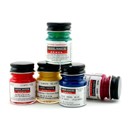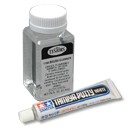

Sopwith Snipe - Late
Unassembled plastic model kit with photo-etch parts.
Customize your model:
Don't forget building supplies!
DISCONTINUED This product has been discontinued
and is no longer available.$79.99
(All prices in U.S. Dollars)
Manufacturer: Wingnut Wings
Stock Number: WNW 32054
Scale: 1/32
View all products of type "Sopwith Snipe"
and is no longer available.$79.99
(All prices in U.S. Dollars)
Manufacturer: Wingnut Wings
Stock Number: WNW 32054
Scale: 1/32
View all products of type "Sopwith Snipe"
This model kit requires assembly. Cement, paint and other construction materials not included unless specifically stated in the description.
Features:
In an effort to improve maneuverability further, later production aircraft featured larger, balanced, upper ailerons and had the fin and rudder areas further increased. The Sopwith Snipe continued to serve the RAF post war, against the Bolsheviks in Russia, occupational duties in Germany, in home service and 'policing duties' in Egypt and Iraq. The Snipe was the last rotary engine powered fighter to serve in the RAF and was only completely replaced in 1927 by the radial engine powered Gloster Grebe, Hawker Woodcock and Armstrong Whitworth Siskin. The Snipe saw very limited foreign use with the Brazilian Navy, Canadian Air Force and Soviet Red Air Fleet.
WW1 aircraft colours are contentious at the best of times and we have done our best to provide what we consider to be accurate painting information. Because Sopwith Snipes were manufactured by over half a dozen companies it is quite likely that they were doped with both PC10 and PC12, although it is only the latter that has been noted on original examples of Snipe fabric we have examined; fabric from late production upper ailerons manufactured by Sopwith (closely matching FS30040) and Whitehead? (closely matching FS26120). There is considerable controversy as to what colour PC10 (Protective Covering number 10) actually was. Made from mixes of yellow ochre, iron oxide and lamp black pigments it varied between olive drab and chocolate brown, depending on the mix and, presumably, time spent exposed to the elements. It appears that fresh PC10 appeared more olive drab while later mixes and aircraft exposed to the elements for some time would appear more chocolate brown. PC12 is slightly less controversial although previous reports of it being red brown are in error and it was actually a dark chocolate brown. The undersides of the wings, tailplane and sometimes the fuselage were left CDL (Clear Doped Linen). A silver dope scheme was introduced post war which was worn by many Snipes. Cowlings, fuselage panels, undercarriage and, remarkably, RAF rigging wires were usually painted 'Service Grey' or with a PC10/12 equivalent. Some aluminium cowls appear to have received a turned metal finish. The interplane and center section struts and their metal fittings also appear to have been painted grey. Steel components, fittings and brackets were often black although many appear to have been finished in grey. All fabric surfaces exhibited a gloss appearance when new which would lose its shine and fade relatively quickly in service.
- High quality Cartograf decals for 5 late production aircraft
- 113 high quality injection moulded plastic parts
- Late production ailerons, fin and rudder
- Highly detailed 230hp BR.2 engine
- 11 photo-etched metal detail parts
- Fine in scale rib tape detail
- Full rigging diagrams
In an effort to improve maneuverability further, later production aircraft featured larger, balanced, upper ailerons and had the fin and rudder areas further increased. The Sopwith Snipe continued to serve the RAF post war, against the Bolsheviks in Russia, occupational duties in Germany, in home service and 'policing duties' in Egypt and Iraq. The Snipe was the last rotary engine powered fighter to serve in the RAF and was only completely replaced in 1927 by the radial engine powered Gloster Grebe, Hawker Woodcock and Armstrong Whitworth Siskin. The Snipe saw very limited foreign use with the Brazilian Navy, Canadian Air Force and Soviet Red Air Fleet.
WW1 aircraft colours are contentious at the best of times and we have done our best to provide what we consider to be accurate painting information. Because Sopwith Snipes were manufactured by over half a dozen companies it is quite likely that they were doped with both PC10 and PC12, although it is only the latter that has been noted on original examples of Snipe fabric we have examined; fabric from late production upper ailerons manufactured by Sopwith (closely matching FS30040) and Whitehead? (closely matching FS26120). There is considerable controversy as to what colour PC10 (Protective Covering number 10) actually was. Made from mixes of yellow ochre, iron oxide and lamp black pigments it varied between olive drab and chocolate brown, depending on the mix and, presumably, time spent exposed to the elements. It appears that fresh PC10 appeared more olive drab while later mixes and aircraft exposed to the elements for some time would appear more chocolate brown. PC12 is slightly less controversial although previous reports of it being red brown are in error and it was actually a dark chocolate brown. The undersides of the wings, tailplane and sometimes the fuselage were left CDL (Clear Doped Linen). A silver dope scheme was introduced post war which was worn by many Snipes. Cowlings, fuselage panels, undercarriage and, remarkably, RAF rigging wires were usually painted 'Service Grey' or with a PC10/12 equivalent. Some aluminium cowls appear to have received a turned metal finish. The interplane and center section struts and their metal fittings also appear to have been painted grey. Steel components, fittings and brackets were often black although many appear to have been finished in grey. All fabric surfaces exhibited a gloss appearance when new which would lose its shine and fade relatively quickly in service.

Copyright © 2005-2024 Scale Hobbyist, all rights reserved




























